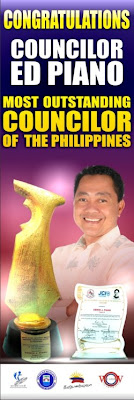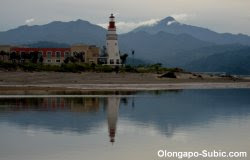By Ansbert JoaquinInquirer News Service
WHAT'S in a shipwreck? A lot, if it's found in Subic Bay.
A seabed of sunken national treasures, Subic Bay has 25 shipwrecks (some accounts estimate 30) that tell a lot about history and the significant role it played in World Wars I and II and during the Spanish occupation.
San Quentin, the oldest known wreck, is a wooden gunboat scuttled by Spaniards in 1898 in a futile attempt to block the channel between Grande and Chiquita islands from the invading Americans.
Oryoku Maru, a Japanese outboard passenger ship, lies 60 feet deep at 300 meters off the Alava pier. It was carrying families and 1,600 American war prisoners when it was attacked by a US aircraft.
The wreck posed navigational risks to arriving US Navy ships, including aircraft carriers, when the port was still used as a US military facility. To remedy the problem, base officials flattened the wreck by blasting it.
One of its cannons is displayed in a restaurant, aptly called "The American Legion,"
on Magsaysay Drive in Olongapo City, just outside the Subic Bay Freeport.
Sean Maru is a 30,000-ton Japanese cargo vessel found between the Alava pier and the northern end of the Subic International Airport runway. It was sunk by the US Navy during World War II.
The USS New York, once the pride of the US fleet in Asia, is the "star" attraction because of its historical value. When the Japanese swept the US Marines out of the Philippines during the war, the Americans had no choice but to scuttle their ship as they left Subic in early 1942 to avoid its capture.
Near the shore
Apart from their historical value, the sunken shipwrecks also serve as recreational dive sites for local and foreign tourists.
"Their attraction can be attributed to their closeness to the shoreline," said dive instructor Butch Horario.
Anilao (in Batangas) has its well-preserved corals, but Subic has its one-of-a-kind historical value, "where you can find plenty of shipwrecks in one area," he said.
The Subic shipwrecks also provide artificial habitat for more than 200 species of fish, replacing the corals that have been destroyed by poaching over the years. The marine abundance, in turn, sustains communities surrounding the bay.
For all their material and environmental value and beauty, the least that mankind can do is protect them. Yet, lately, the wrecks have been the targets of looters who threaten to destroy their historical value. Looting is also threatening the Subic communities' livelihood, recreational diving, and fish habitat.
Looting, according to divers, has been going on for years. And while looting cases have been on the rise lately, the treasures always end up in souvenir shops and junkyards.
While visiting the USS New York during a recreational dive on June 13, Horario said he saw a hacksaw and a hookah hose, and immediately suspected that looting was taking place. He later discovered that the vessel's pipes, cables and portholes were missing.
He immediately reported the incident to the Subic Bay Metropolitan Authority (SBMA) harbor patrol, but so far, nothing has come out of it.
A month later, on July 11, the SBMA tourism department and the Philippine Coast Guard station in Subic town foiled another attempt to loot a sunken vessel off Baloy Beach in Barangay Barretto, Olongapo City.
An SBMA official said a small ship that looked like a Japanese landing craft, or what was left of it after previous lootings, was recently unearthed 15 meters inland in Sitio Minanga in Morong, Bataan.
Remnants of the ship were found on a beach-front property owned by an official of the Bataan Techno Park. The "scrap," which was found by workers clearing the area for a casino project, was cut to pieces to be sold to junk shops, the SBMA official said.
Another shipwreck
In another account three years ago, according to an SBMA document, Brian Homan, an Australian dive shop and restaurant owner at the freeport, brought several witnesses to an SBMA office to testify on a shipwreck looting incident. After an investigation, the SBMA cancelled the accreditation of the suspect, Belgian Johan Desadeleir, who owns a dive shop called Johan Adventure Diving in Barretto.
Desadeleir sued Homan for libel. Three months later, the SBMA brokered an agreement between the two foreigners: Desadeleir was to withdraw the case against Homan in exchange for the renewal of his accreditation. The suspect's accreditation was eventually renewed, but the libel suit was not dropped.
The Inquirer visited Desadeleir's shop on July 18 and 26, but failed to reach him for comment.
Another diving enthusiast has accused the SBMA and Homan, who also operates a museum, of looting the USS Lanikai of its artifacts when the ship was found in 2003. The century-old wooden ship sank in the Nabasan Bay 59 years ago.
Dive shop owner Jim Robertson defended Homan, saying the latter "had [the] permission of the National Museum."
"They have been taking artifacts from the Lanikai, but apparently, they have the go ahead from the SBMA and the National Museum. They brought up some artifacts but those are supposed to be displayed at his (Homan's) place," Robertson said.
"I think whatever they recovered, Homan was allowed to keep a portion or whatever [of the find]."
Collection
Dive master Earnest Elduayan agreed. "If you go to the National Museum, you will see his collection of jars-1500s, 1600s, Ming Dynasty, Tang Dynasty-everything is there. Homan donated those to the Philippines after he found them in Mindoro," Elduayan said.
Homan declined to be interviewed by the Inquirer at length. But he said he felt abandoned by the SBMA when it renewed Desadeleir's accreditation.
"And this you can quote me-ankle weights, crowbars, hammer and chisels are not the ordinary tools of fun divers," he said.
"Right or wrong, that is between Brian and Johan," Robertson said.
"I don't think they are even suspects. If Brian is going to take something, he is going to take it whole. Whatever he has now was acquired through legal means," he added.
Despite their differences, rivalries and bickering, the dive shop owners agreed on two things: a large part of the loot goes to the junk shops, and the solution to the problem is simply law enforcement.
"Souvenir lovers are not going to take a piece of anything. They want something whole, an artifact that they can make use of," Robertson said.
By their own estimate, divers said tons of metals were lost to small-time looters every year. If a kilogram of copper was sold at local junk shops at P100, a ton of it a year would cost only P100,000. Brass could fetch a higher price, Horario said.
"They might not be aware of it, but looters do not only threaten to destroy the shipwrecks' historical value and Subic's marine life and tourism potential. They also risk even their own lives when they are not experienced in the proper way of diving and ascending in deep waters," Horario said.







